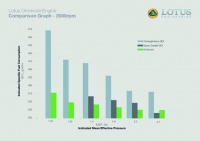Two-stroke engines are dirty and noisy; that’s the common perception at least. But according to engineers at Lotus, a new breed of ultra-efficient two-stroke, a world removed from the puttering, dribbling power-train of the low-cost moped, may one day steal the four-stroke’s thunder.

The initial programme was carried out in collaboration with Queen’s University Belfast and Orbital Corporation Australia. Lotus is now looking for further backing to share the risk and to take the project to the next level, which would involve developing a multi-cylinder variant and ultimately fitting a test engine to a car. So far, said Turner, the concept has certainly generated plenty of excitement. ’We’ve had a lot of interest from OEMs, which is good because everyone’s grappling with how to get CO2 down in the future so we’re hoping to form some kind of consortium that will enable us to fully map the engine and take the engine design forward. I believe the engine has significant legs on it.’
There’s a long way to go before the engine makes it anywhere near a car — Turner estimates three years with a favourable wind — but considering how fundamentally different it is, the project has already come a long way.
Recalling the light-bulb moment when a colleague suggested putting a VCR system in a two-stroke engine, Turner believes the new engine is a great example of the importance of a creative, cerebral approach to engineering. He finished by saying: ’The overall process was one of invention rather than computation. You would not have arrived at this solution through just running endless computer simulations, because pretty much all of the tools that the industry uses are based around four-stroke engines.’
Two-stroke cars
A number of manufacturers have used two-stroke engines in the past
- 1950 Swedish car-firm Saab introduces a two-stroke engine on the Saab 92, based on the design of the German car marque DKW
- 1955 Suzuki launches the Suzuki Suzulight (360cc, two stroke) which helps to usher in Japan’s light-weight car age
- 1957 East German car maker VEB Sachsenring launches the infamous Trabant 500, the first of three versions of the Soviet-era car to be powered by a two-stroke engine
- 1964 DKW launches the F102, the last in a long line of two-stroke engined cars and the direct forerunner of the first post-war Audi (which used a conventional four-stroke engine)





Nanogenerator consumes CO2 to generate electricity
Whoopee, they've solved how to keep a light on but not a lot else.